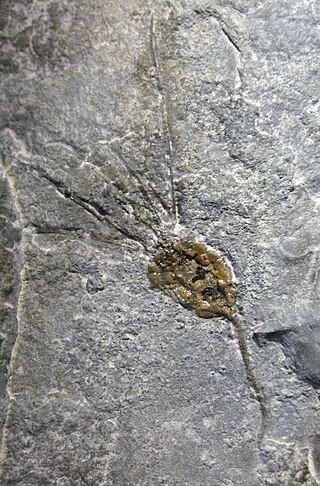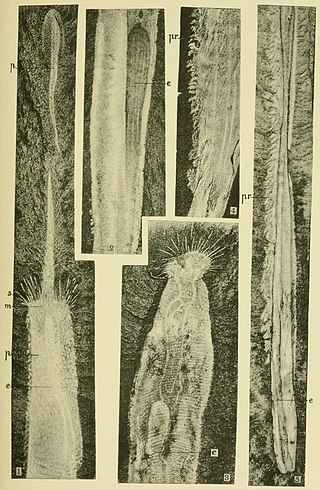
Kootenia is a genus of trilobites of the family Dorypygidae. 118 specimens of Kootenia are known from the Greater Phyllopod bed, where they comprise 0.22% of the community. Its major characteristics are that of the closely related Olenoides, including medium size, a large glabella, and a medium-sized pygidium, but also a lack of the strong interpleural furrows on the pygidium that Olenoides has.

Gogia is a genus of primitive eocrinoid blastozoan from the early to middle Cambrian.

Olenoides was a trilobite from the Cambrian period. Its fossils are found well-preserved in the Burgess Shale in Canada. It grew up to 10 cm long.
Dictyophycus is a putative red alga of the middle Cambrian Burgess shale. While alive, it formed leaf-like lobes about 25mm across. The fossils do not preserve the leaf-like membrane, so only the sturdier "skeleton" is known; these are usually broken and detached from their holdfast. 308 specimens of Dictyophycus are known from the Greater Phyllopod bed, where they comprise 0.59% of the community.
Liangshanella is a genus of Cambrian bradoriid known from the Chengjiang biota and Burgess Shale. 6263 specimens of Liangshanella are known from the Greater Phyllopod bed, where they comprise 11.9% of the community.

Morania is a genus of cyanobacterium preserved as carbonaceous films in the Middle Cambrian Burgess Shale. it is present throughout the shale; 2580 specimens of Morania are known from the Greater Phyllopod bed, where they comprise 4.90% of the community. It is filamentous, forms sheets, and resembles the modern cyanobacterium Nostoc. It would have had a role in binding the sediment, and would have been a food source for such organisms as Odontogriphus and Wiwaxia.

Herpetogaster is an extinct cambroernid genus of animal from the Early Cambrian Chengjiang biota of China, Pioche Formation of Nevada and Middle Cambrian Burgess Shale of Canada containing the species Herpetogaster collinsi and Herpetogaster haiyanensis.
Chaunograptus is a genus of putative graptolite known from the Middle Cambrian Burgess Shale. 11 specimens of Chaunograptus are known from the Greater Phyllopod bed, where they comprise 0.02% of the community.
Bosworthia is a genus of branching photosynthetic alga known from the Middle Cambrian Burgess Shale. 20 specimens of Bosworthia are known from the Greater Phyllopod bed, where they comprise 0.04% of the community. One of its two original species has since been reassigned to Walcottophycus.
Ehmaniella is a genus of trilobite known from the Middle Cambrian Burgess Shale. 392 specimens of Ehmaniella are known from the Greater Phyllopod bed, where they comprise 0.74% of the community.

Emeraldella is a genus of arthropod known from the Middle Cambrian of North America. The type species E. brocki was described in 1912 from the Burgess Shale. 21 specimens of Emeraldella are known from the Greater Phyllopod bed, where they comprise < 0.1% of the community. A re-study on the species was done in 2012. A second species E. brutoni is known from the Wheeler Shale, which was described in 2011. An additional specimen of E. brutoni was described in 2019, which revealed more of the anatomy. It has been placed as a basal member of the clade Vicissicaudata within Artiopoda, a group of arthropods containing trilobites and their relatives.
Mackenzia is an elongated bag-like animal known from the Middle Cambrian Burgess Shale. It attached directly to hard surfaces, such as brachiopod shells. 14 specimens of Mackenzia are known from the Greater Phyllopod bed, where they comprise <0.1% of the community. Mackenzia was originally described by Charles Walcott in 1911 as a holothurian echinoderm. Later, Mackenzia is thought to be a cnidarian and appears most similar to modern sea anemones.

Micromitra is a genus of brachiopods known from the Middle Cambrian Burgess Shale. 160 specimens of Micromitra are known from the Greater Phyllopod bed, where they comprise 0.3% of the community.

Louisella is a genus of worm known from the Middle Cambrian Burgess Shale. It was originally described by Charles Walcott in 1911 as a holothurian echinoderm, and represents a senior synonym of Miskoia, which was originally described as an annelid. 48 specimens of Louisella are known from the Greater Phyllopod bed, where they comprise < 0.1% of the community. It has been stated to have palaeoscolecid-like sclerites, though this is not in fact the case.
Paterina is a genus of brachiopods known from the Middle Cambrian Burgess Shale. 18 specimens of Paterina are known from the Greater Phyllopod bed, where they comprise 0.03% of the community.

Pollingeria is a problematic genus of animals of the Middle Cambrian Burgess Shale. 3080 specimens of Pollingeria are known from the Greater Phyllopod bed, where they comprise 5.85% of the community.

Oryctocephalus is a genus of trilobite known from the Middle Cambrian Burgess Shale. 24 specimens of Oryctocephalus are known from the Greater Phyllopod bed, where they comprise 0.42% of the community. This small- to medium-sized trilobite's major characteristics are prominent eye ridges, pleural spines, long genal spines, spines on the pygidium, and notably four furrows connecting pairs of pits on its glabella. Juvenile specimens have been found with only 5 or 6 thoracic segments and about one eighth of adult size, as well as about 2 mm wide.
Protospongia is a genus of Porifera known from the Middle Cambrian Burgess Shale. 102 specimens of Protospongia are known from the Greater Phyllopod bed, where they comprise 0.19% of the community.
Wahpia is a genus of alga known from the Middle Cambrian Burgess Shale. 33 specimens of Wahpia are known from the Greater Phyllopod bed, where they comprise 0.06% of the community.

Diagoniella is a genus of sponge known from the Middle Cambrian Burgess Shale. 128 specimens of Diagoniella are known from the Greater Phyllopod bed, where they comprise 0.24% of the community.










